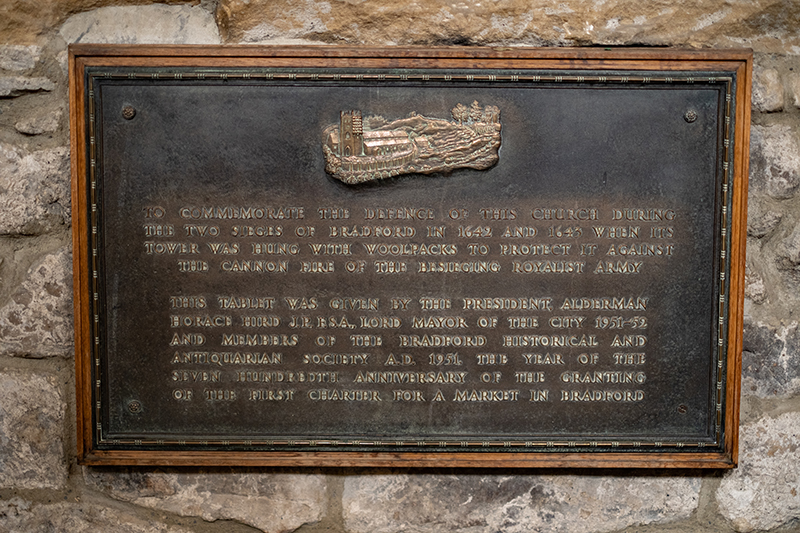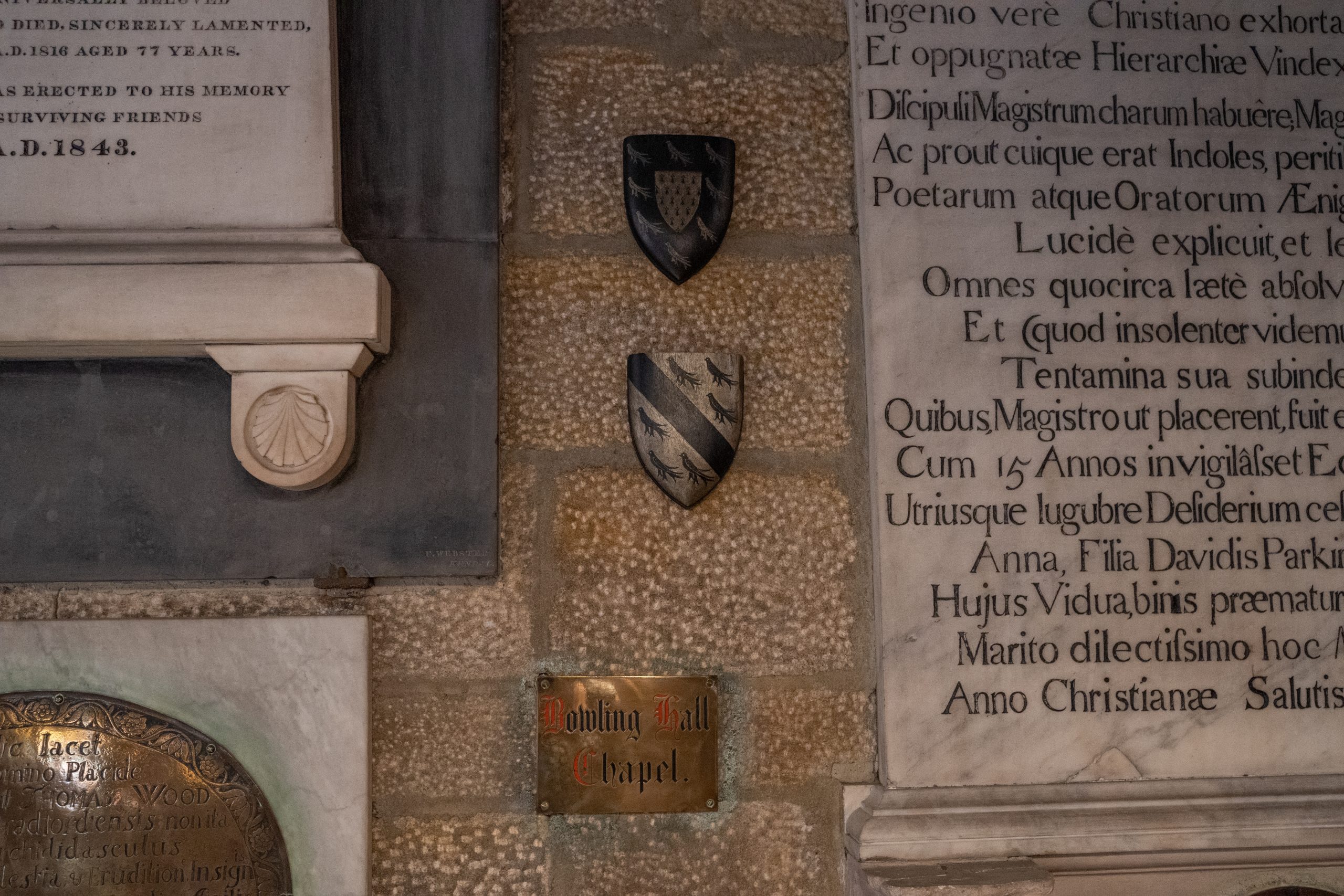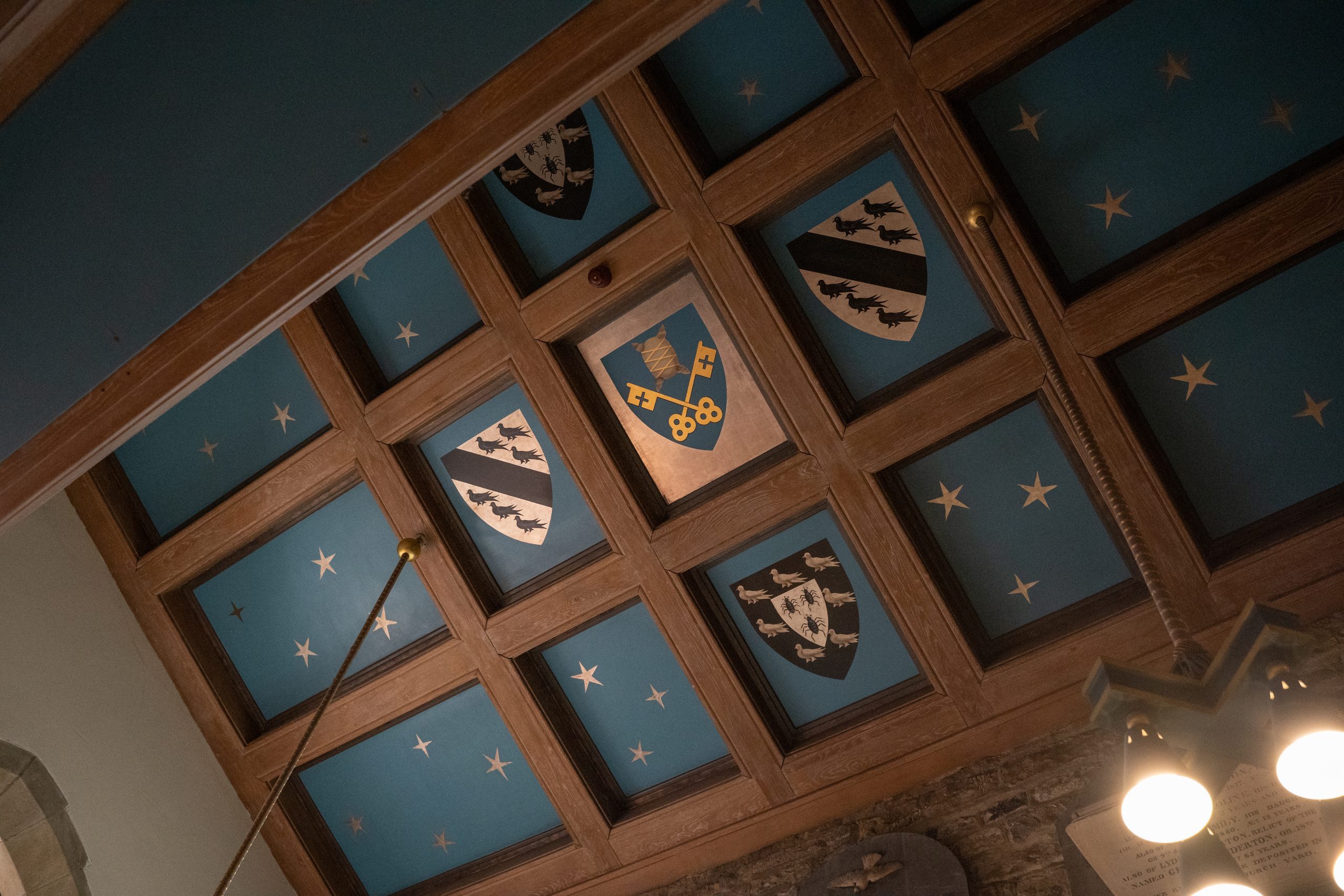Monuments and Memorials
The Market Charter and Battle(s) of the Steeple Plaque
The bronze plaque remembers two major events in Bradford’s history: the granting of a market charter in 1251, and the Battle(s) of the Steeple in 1642/3 during the Civil War.
The plaque was installed in 1951, the 700th anniversary of the granting of the market charter. The original market charter was for Thursdays, and at one time the markets were held in the churchyard on Sundays to avoid the need for people to come into Bradford twice a week. The market was later moved to the junction of Kirkgate, Ivegate and Westgate which has long been the ‘home’ area of the Bradford markets. The remains of the old market cross now stand in the Westgate entrance (top section) of the Kirkgate Centre.

The Battle(s) of the Steeple
In the English Civil War, Bradford was involved in encounters between the rival Royalist and Parliamentarian armies on 5 occasions between October 1642 and March 1644 and the Cathedral tower (then Bradford Parish Church) was at the centre of some of the fierce fighting. During the Civil War sieges of Bradford in 1642 and 1643, Royalist forces attacked the town, which had fewer than 3,000 inhabitants. In July 1643, after Sir Thomas Fairfax retreated from the battle of Adwalton Moor, the church tower came under threat from Royalist cannon fire and was hung with woolpacks for protection, an event known as the Battle of the Steeple. Cannonballs have since been unearthed at the foot of the tower. The woolpack on the Cathedral coat of arms is a reminder that the church was saved from destruction in this way during the Civil War.
The Turner/ Whyte-Watson Memorial- North Transept
This plaque acknowledges the achievements in the development of chemotherapy in Bradford by Robert Lowry Turner and George Whyte-Watson. George Whyte-Watson was appointed consultant surgeon to St. Luke’s Hospital and Bradford Royal Infirmary in 1946; Robert Lowry Turner became Consultant Pathologist at Bradford Royal Infirmary in 1956. They are best known for their collaborative and pioneering work in the treatment of breast cancer after their research in the use of chemotherapy. A local research base for them was provided by the University of Bradford.

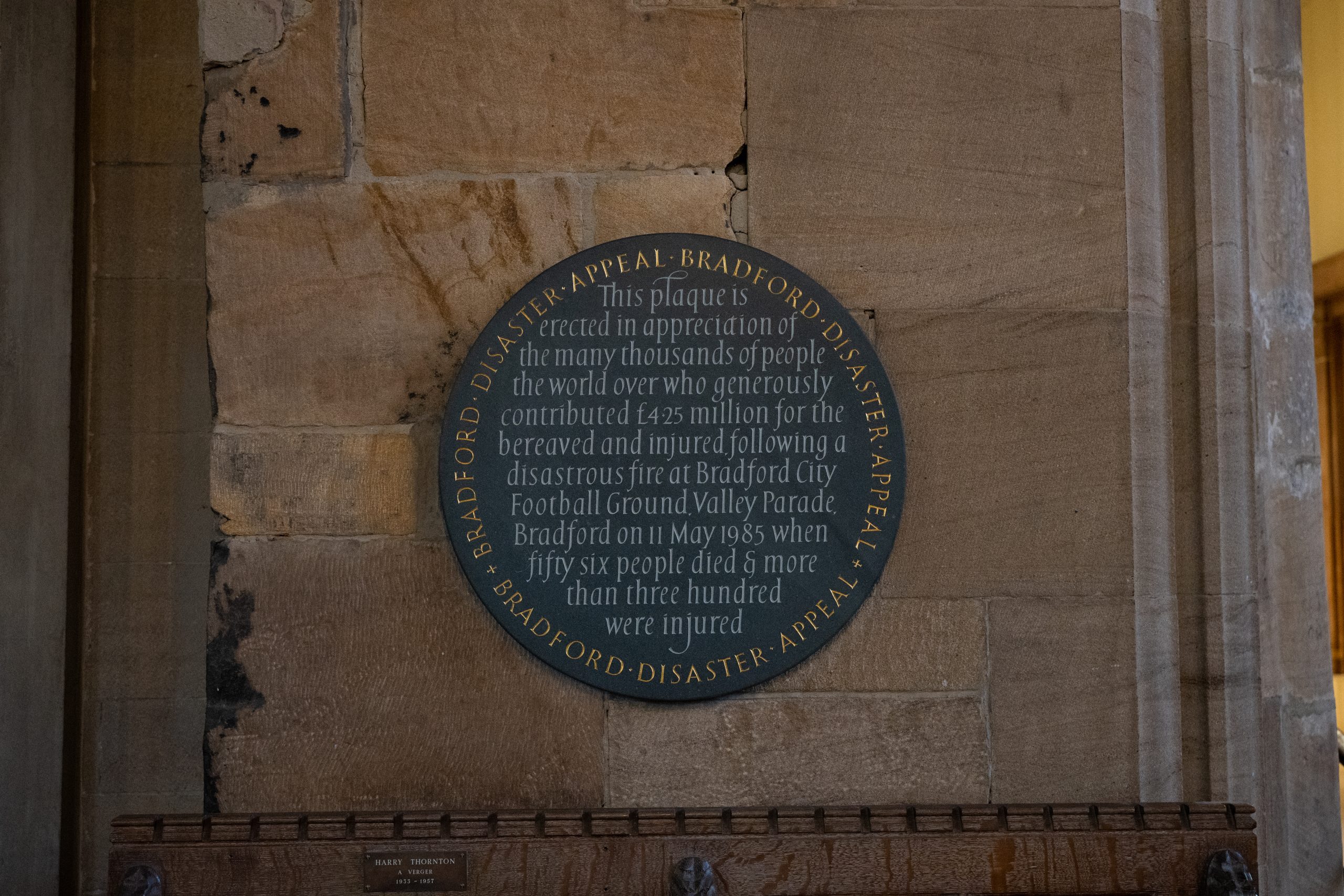
The Bradford City Football Ground Fire Disaster Memorial- North Transept
This memorial remembers the Bradford City Football Ground Fire Disaster, at Valley Parade on 11th May 1985. This circular slate, picked out in letters of gold and white, commemorates that fifty-six people died and more than three hundred were injured in the disastrous fire. The tremendous efforts of many in the city to alleviate resulting suffering led to innovations in the treatment of burns, and in disaster relief across the world. Many thousands of people the world over contributed £4.25 million for the bereaved and injured. On the day following the disaster there was a memorial service for those who had died and the fans filled the building in a very moving service. Many wore their City ‘strip’ and there were some who were bandaged from their injuries and still in pain.
The Queen’s Stone- South Ambulatory
The Queen’s Stone, commemorates the visit of Her Majesty Queen Elizabeth II for the presentation of the Royal Maundy in 1997, during Bradford’s centenary celebrations of being granted city status in 1897.
On the Queen’s Stone, as well as the date of the Queen’s visit, an inscription reads: “This ancient custom of royal generosity and humility has been observed by the British Crown since Medieval times. It commemorates Jesus washing the disciples’ feet at the Last Supper”.
“Maundy” is derived from the Latin word “mandatum”, which means “commandment”, commemorating the fact that Jesus gave his disciples a new commandment on this day. Maundy Thursday is the Thursday before Easter.
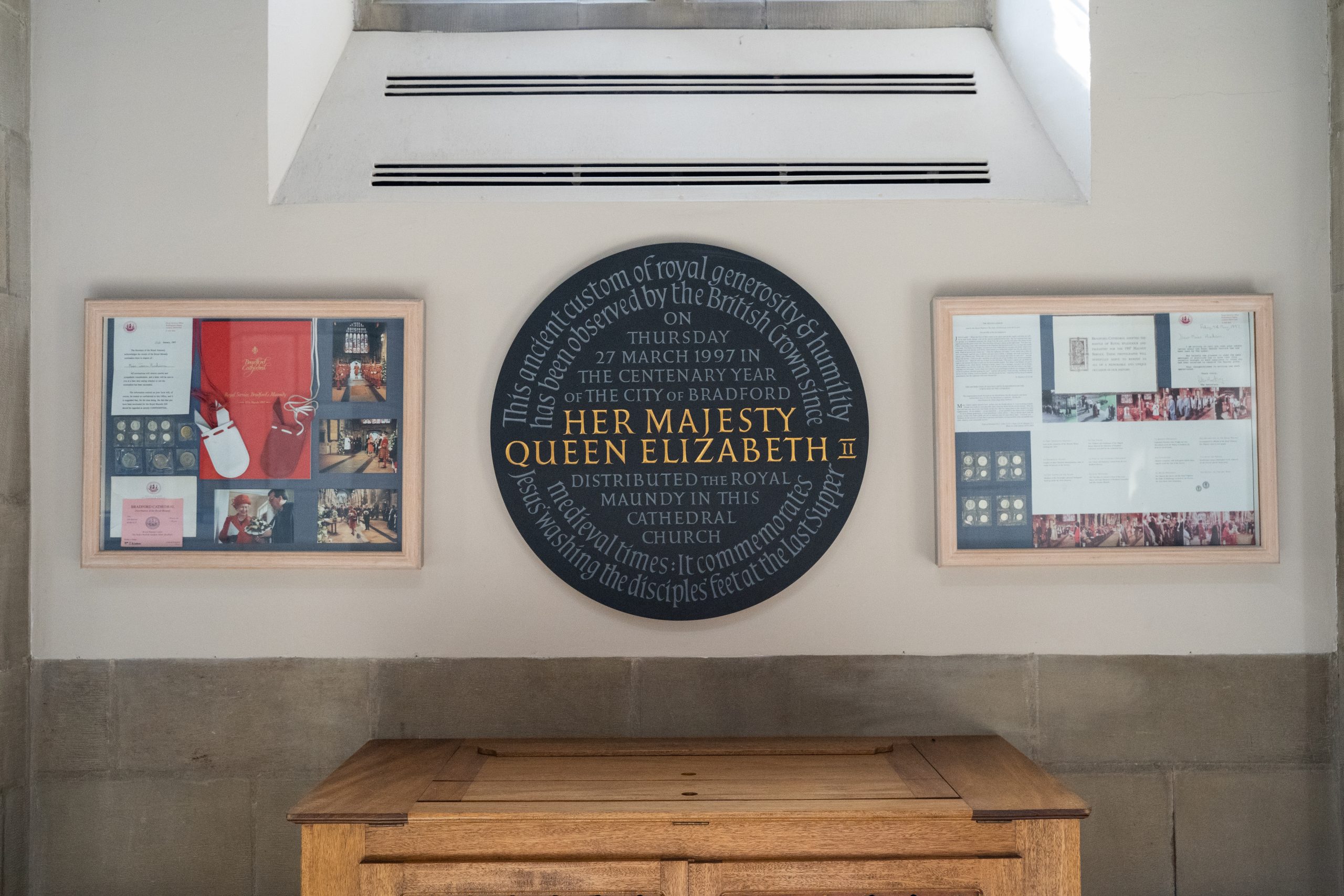
Traditionally, the Royal Maundy services took place in or near London, but during her reign Queen Elizabeth II has been keen to perform the ceremony in different parts of the country, and by 2017 it had taken place in every English Cathedral during her reign. In 1997, a very special year for the city because of its centenary celebrations, Bradford was chosen.
The Queen symbolically distributes the Maundy money to a number of men and women according to the years she has been living, so in 1997 at Bradford, 71 men and 71 women were chosen. The coins are presented to the recipients in red and white purses. The Maundy money, the amount also being the same as the years that the Queen has been living at that time, is given out in the white purse. In the red purse is a small sum of ordinary money in lieu of gifts of food and clothing that the monarch once gave to Maundy recipients.
You can see examples of the coins and purses, as well as some photos and other memorabilia of the event, on the wall of the South Ambulatory, next to the Queen’s Stone.
The Bollings and the Bolling Chapel
The South Ambulatory was originally the private chapel of the Bolling family and was known as the Bolling Chapel- or the Bowling Hall Chapel as it says on a plaque in that area- up until the extensions of the 1960s.
The Leventhorpe Chapel (now part of the North Ambulatory) and later the Bolling Chapel were among the first parts of the third church to be built and were originally proprietary chapels for these two prominent Bradford families at that time. Building began in 1360-1380. Pestilence slowed and stopped the work from 1379. The third church was completed in 1458.
The Bolling family also had their own entrance to the church, which can now be faintly seen as a blocked up doorway in the wall. This chapel and the Leventhorpe Chapel were both dissolved when their endowments were seized during the Reformation.
The Bolling Chapel became the family pew of the Tempests after the Reformation. The Chapel gave way in 1615 and had to be rebuilt. It was built- particularly the windows- in a different style from the rest of the church, the Jacobean style of the time.
The Bollings, original Lords of the Manor of Bollinge, built Bolling Hall. Sir Richard Tempest married Rosamund, the last of the direct Bolling line, in 1497. Sir Richard Tempest was largely responsible for the building of the Tower, completed in 1508.
There are several Bolling family memorials in this area and the ceiling of the Chapel is decorated with the arms of the Bolling and Tempest Mitchell families. This ceiling was put up when the Cathedral was extended and renovated in the 1950s-1960s. Outside, on one of the southern buttresses, is a weathered stone shield bearing the Tempest arms impaling those of Bolling. The Mason tomb served as an altar for a while when this was still a chapel (before the 1950s/1960s). The Mason family lived at Bolling Hall early in the 19th century. When Mrs. Tempest sold and left Tong Hall she was the last of the Tempests to live there. She gave 2 small shields, bearing the Tempest arms.
We know from records that a number of the Bolling family are buried here, but around 1666 the church floor was raised four feet, sealing many of the graves and vaults. When the 1960s renovations and extensions were done, no Bolling graves or vaults were uncovered- leading to the conclusion that they must be further down or had been covered over.
Records tell us that:
- Robert Bolling, by will proved 1487, directed his body to be buried before the altar of Bradford Church
- Tristram Bolling of Chellow, made his will 3rd January 1502, his body to be buried in the “High Queere” of Bradford Church.
- Sir Richard Tempest, of Bolling Hall, by will 1537, directed his body to be buried in “Our Lady’s Queere” in the Church of Bradford
Written in Stone
For English Tourism Week 2023 we looked at ten monuments, objects and items in the Cathedral that were ‘written in stone’ – and you can watch them all back here.
To view a particular video in the series, click the drop down menu in the YouTube embed and pick it from the list.
Review of Monuments and Memorials
Along with other cathedrals and institutions, in response to national and international events and the Archbishop of Canterbury’s call for a review of the Church of England’s built heritage, Bradford Cathedral is undertaking a detailed review of its monuments and memorials.

